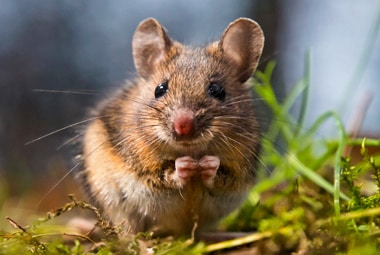
Meadow mice have a short stocky body that is brown in color. They have short ears, a short tail, and blunt-nose. Adults grow to be about 3-5 inches in length not including their tail; they can weigh between ¾ and 2 ½ ounces. They have an overall mouse-like appearance.
| Pest Identification | |
|---|---|
| Recognition | Meadow mice have a short stocky body that is brown in color. They have short ears, a short tail, and blunt-nose. Adults grow to be about 3-5 inches in length not including their tail; they can weigh between ¾ and 2 ½ ounces. They have an overall mouse-like appearance. |
| Biology | Meadow mice are capable of breeding year-round, although the number of young born will peak during the spring and fall months. After mating, there is a 3 week gestation period; the females will then give birth to between 1 and 8 young. The young meadow mice are born hairless and helpless, but mature quickly. They are ready to wean at 2-3 weeks of age. Females become sexually mature at only 25 days and males at about 5 weeks of age. Most females produce 1 to 5 litters per year, although it is possible for a female to produce a new litter each month, making them one of the most fertile rodent species. |
| Habits | Meadow mice are typically found living outdoors and rarely come into homes and other buildings, but when they do, they will come in on the first floor. They live outside in areas where there is cover from thick vegetation or in fields next to lakes, ponds, streams, and swamp lands. They create their burrow underneath loose soil, in lawns, under piles of dead leaves or grass, and underneath mulch. Meadow mice live, nest, and store food in their burrows. Meadow mice are mostly active at night and feed mainly on plants. Their diet consists of steams, leaves, roots, flowers, seeds, fruits, bark of trees, and sometimes insects and other small animals. Meadow mice don’t pose any real known health risks to people, but they can be responsible for costly and extensive damages to lawns, plants, agricultural crops, and trees (feeding on the bark). |
| Prevention | It is very difficult to prevent meadow mice from choosing your property to inhabit; the best way to control them is to have a year-round rodent control program in place for your Missouri home and property. However, there are a few things you can do to help prevent and deter them: *Remove piles of grass, leaves, and other debris from your property, *Keep your lawn trimmed short, *Trim back trees and overgrown vegetation from the outside of your home, *Install door sweeps on all exterior door, *Seal gaps and cracks found in the foundation of your home. |
| Professional | Meadow mice can reproduce very quickly; which means that in a short time, a small problem with these pests can become a very big problem. Rottler Pest Solutions can provide safe and effective services to get rid of Meadow mice through our rodent exclusion services. Rottler’s rodent exclusion services provide our customers with the following: inspection services to correctly identify the species of rodent infesting your property, discovery of entry and exit points into your home, sealing off of these entry and exit points, and placing baits and/or traps as needed. |

